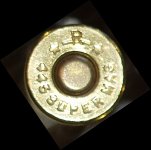I only started loading 45 Colt last year. Cowboy loads for revolvers are great, but I also have a Marlin 1894 Cowboy Carbine and several new Winchester 1892s. I would like to load some hotter rounds for the rifles that should NOT go in single action revolvers.
What's the best way to clearly differentiate the rifle-only cartridges? I probably will use different bullets so maybe anything with a jacket should be considered "rifle only", but is there a good way to make the case head red or otherwise color the case?
While I'm at it, does anyone have experience with Sierra's 240 grain jacketed hollow cavity bullets in a rifle?
What's the best way to clearly differentiate the rifle-only cartridges? I probably will use different bullets so maybe anything with a jacket should be considered "rifle only", but is there a good way to make the case head red or otherwise color the case?
While I'm at it, does anyone have experience with Sierra's 240 grain jacketed hollow cavity bullets in a rifle?


